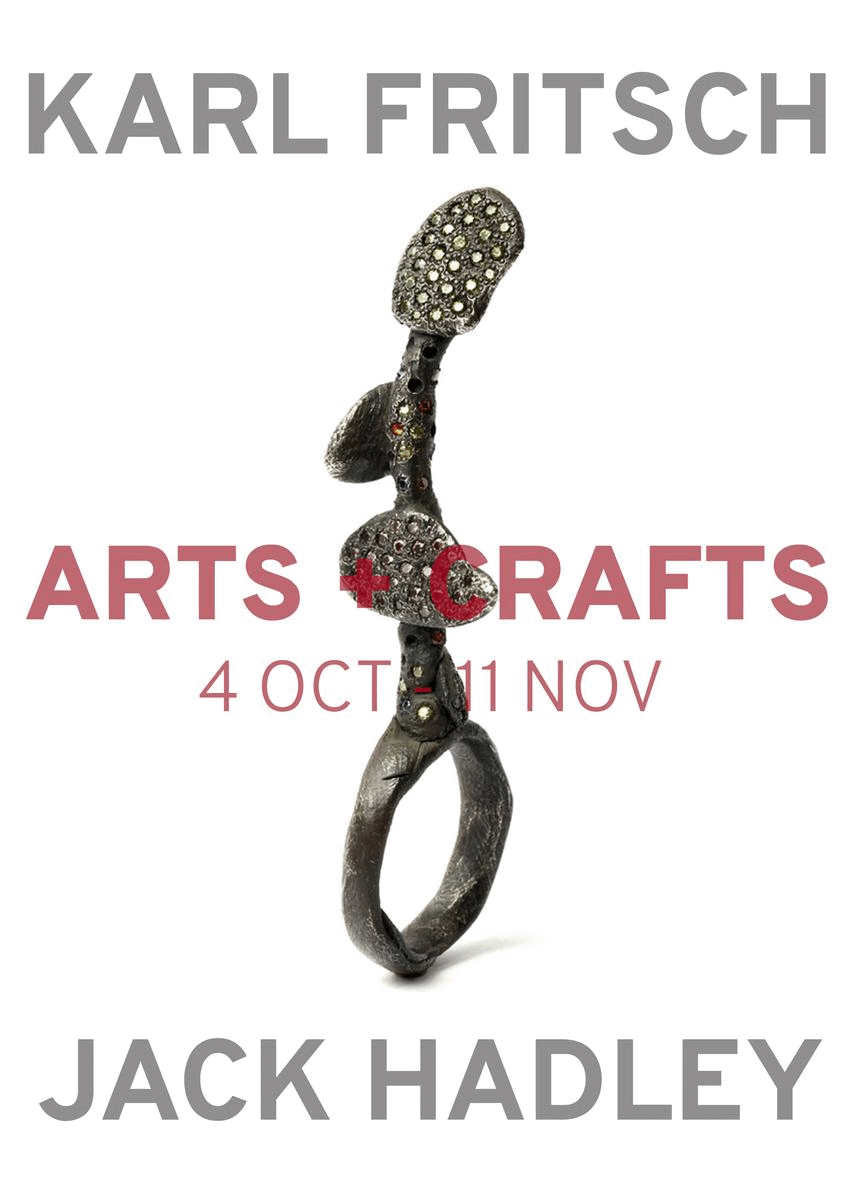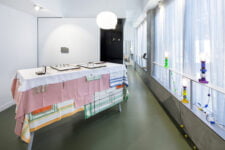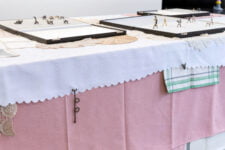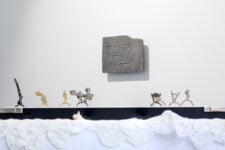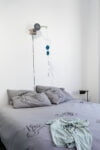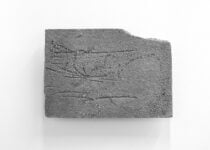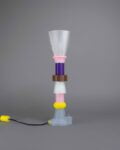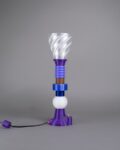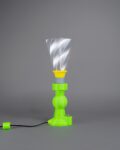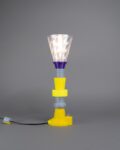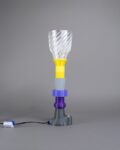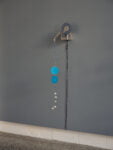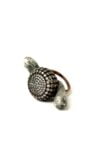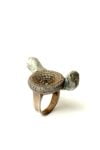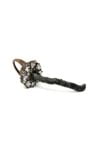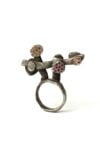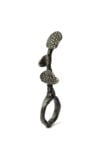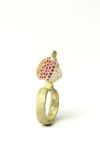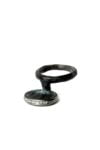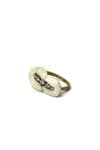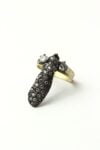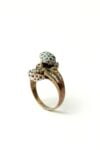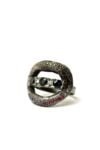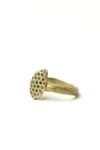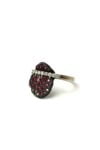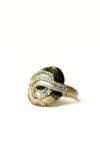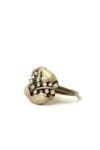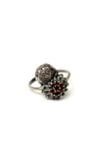Karl Fritsch & Jack Hadley: Arts & Crafts
Creative Convergence
Arts & Crafts is a joint exhibition that brings together the distinctive world of Karl Fritsch and Jack Hadley. Considering their practices share similar guiding principles, where play is used as an instrument to subvert convention, the meeting of Fritsch and Hadley seems almost pre-destined. The duo met when they were paired up in HandShake 6, an esteemed jewellery mentorship program in Aotearoa New Zealand orchestrated by the creative minds at Makers 101, where Fritsch served as Hadley’s mentor.
Fritsch titled the exhibition in reference to his and Hadley’s formative training. Fritsch mastered the craft of goldsmithing at Goldschmiedeschule Pforzheim before studying under renowned jewellers Hermann Jünger and Otto Künzli at Akademie der Bildenden Künste in Munich between 1987 and 1994. Hadley has a fine arts background, holding a BFA (2012) and an MFA (2021) from Elam School of Fine Arts in Tāmaki Makaurau Auckland. Taking in Fritsch’s panache for disruptive humour within his works, the choice of this title can also be read with irreverence. The distinction of arts and crafts is often arbitrary and both artists have developed a practice that spans across mediums and forms, from contemporary jewellery to sculpture, furniture to studio pottery. Both often incorporate contradictory elements in their works, which challenge and upset societally accepted norms – of beauty, preciousness, and the very boundaries of art. Therefore, instead of division, the title refers to the coming together of seemingly disparate fields and a nod to the domestic decorative objects presented in the exhibition.
Finding one term that captures the soul of Fritsch’s practice is a challenging endeavor as his works carry a rich vocabulary that defies strict categorization. Within jewellery, Fritsch works predominately with rings where he propels his goldsmithing skills with his delicious wit, creating wearable pieces of abstractions that intrigue with their beguiling tactility. Trying on one of Fritsch’s rings is not solely an act of adornment; it is a journey of exploration. Each piece contains texts and forms held within distinctive miniature landscapes. Fritsch’s selection of rings for Arts & Crafts conjures up images of forgotten ruins concealing glittering treasure, sparkling foliage blooming across alien terrain, and Foucaultian towers guarded by menacing weapons. Each one beckons you to study its contrasting typography and step through a portal into a different land. Like traversing the pages of a fairy tale, the ultimate test is finding that perfect, enchanting fit.
While Fritsch is known for his jewellery, he defies artistic constraints and is constantly experimenting through collaboration and inquiry into the materials that exist around him. A few years back, captivated by a friend’s screen-print of a seaweed, Fritsch began collecting kelp that washed up on the beach after a storm. As the collection amassed and started to envelop his studio, it sparked Fritsch to turn the oceanic treasures into light fixtures. They range from organic shapes encircling exposed bulbs to a curtain of kelp entangled with vintage shades reminiscent of jellyfish - a captivating dance where nature harmonies with the manufactured. In recent years, Fritsch has come to boldly install his kelp lamps alongside exhibitions of his rings. While customs regulations prohibit their inclusion in Arts & Crafts, it's important to acknowledge this body of work as it reflects Fritsch’s consideration of how people engage with his jewellery. In designing the environment in which his rings are experienced, he compels a broader narrative that disposes of dichotomies, where beauty emerges from chaos tinged with just the right hint of monstrosity. In the context of this exhibition, it forges an immediate link to the works presented by Hadley.
In the kaleidoscopic realm of Hadley's creations, beige finds no sanctuary. Every element in his work boldly flaunts its chosen colour, vibrating with vivid intensity. Besides an electric palette, Hadley embraces clean, geometric shapes. For Hadley, making is an act of play. Thus, the process of making becomes a device to interrogate the designs of our built environment. Drawing from classical orders to children’s playgrounds and the very tools used to create buildings, the simplistic aesthetic of Hadley’s creations works as a counterbalance to the layers of questions he poses and explores. Hadley openly credits the Memphis Design Style as an influence, a movement driven by rebellious spirit beneath its visually striking surface. His synthetic pop creations embody this spirit, fearlessly pushing the boundaries of architectural norms in miniature with joyful defiance.
For Arts & Crafts, Hadley unveils a striking collection of 3D printed lampshades, an expansion of his foray into furniture designs. These luminous creations originate as digital models constructed from 'solid primitives,' rudimentary forms instructed from basic commands such as ‘cylinder’ and ‘box’ in AutoCAD (Computer-Aided Design Software). These primary shapes are then combined with a threaded shank and hole, enabling them to be seamlessly assembled into elegant columns that form the base of lamps once they emerge from the 3D printer. Seeking simplicity in form, Hadley opted for a timeless cone shape for the lampshade, ingeniously inverting it to impart an anthropomorphic quality. Balancing the imperative for translucency with structural integrity, the lampshade also embraces a spiral design, paying homage to the charming kitsch of lampshades' past and echoing the mechanics of their base assembly. This playful fusion exemplifies Hadley's mastery of blending elements often perceived as opposites—tradition and technology, refinement and tack, restraint and excess. Beneath the child-like surface of colourful jubilation in Hadley’s works lies a rich interplay that transcends initial impressions and engages with historicizing elements.
The captivating worlds of Fritsch and Hadley invite rebellious fun and blurred categories. The works presented in Arts & Crafts showcase how each artist intersects common conventions with their shadow parts, challenging accepted standards and divisions. In a world increasingly obsessed with differences rather than similarities and cementing rigorous dichotomies, their works prompt us to reconsider the relevance and artifice of categories, erasing the lines that society so eagerly draws. Perhaps the most important word in the title is not arts nor crafts, but the ampersand that brings the two worlds together. Arts & Crafts is not just a showcase of new works but a testament to the power of creative exploration and a reminder that boundaries are imagined.
Grace Lai
Curator of Applied Arts & Design, Tāmaki Paenga Hira Auckland War Memorial Museum
Arts & Crafts catalogue
